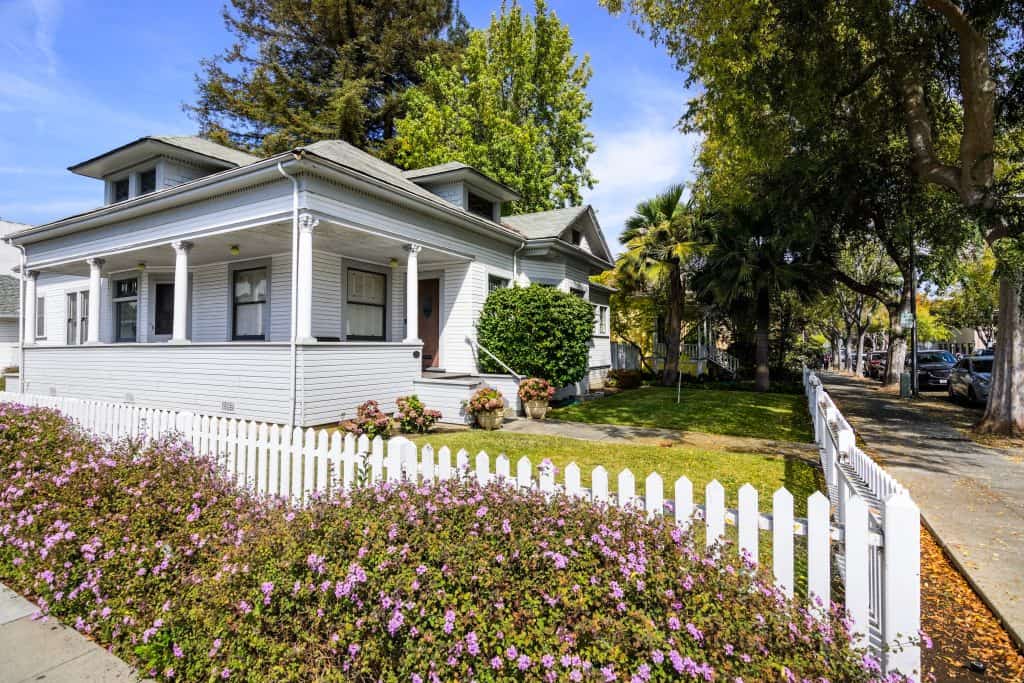Are you ready to upgrade your fencing and make an eco-friendly choice?
In 2023, sustainable fencing materials are stealing the spotlight for homeowners like you. Bamboo, reclaimed wood, and composite materials made from recycled plastics are among the top options, offering a stylish look while reducing your environmental impact.
Mixing materials like metal and wood or glass and concrete creates visually striking contrasts, while vertical lines provide a modern aesthetic and enhance the perception of height and space.
Discover how you can make a positive impact on the environment without compromising on style.
Key Takeaways
- Bamboo, reclaimed wood, and composite materials made from recycled plastics are trending sustainable materials for fencing in 2023.
- Mixing and matching materials like metal and wood or glass and concrete is a popular trend in fencing design.
- Vertical lines in fencing provide a modern aesthetic and enhance the perception of height and space.
- Minimalist designs with clean lines and neutral colors are on-trend for a sleek and uncluttered appearance.
Bamboo
Bamboo, being a renewable resource that requires minimal water and no chemicals, is a strong and cost-effective option for eco-conscious homeowners. When it comes to sustainable fencing, bamboo stands out as an excellent choice.
Not only is bamboo an organic material, but it’s also incredibly durable and long-lasting. Its strength is comparable to wood, and it can withstand hurricane winds without weakening. Additionally, bamboo is resistant to termites, making it a reliable option for protecting your property.
Another advantage of bamboo is its lightweight nature, which makes it easy to install. Furthermore, bamboo is a cost-effective solution for those looking to go eco-friendly without breaking the bank.
Reclaimed Wood
You can consider using a few planks of reclaimed wood for your fence, as they offer a stylish and eco-friendly alternative. Reclaimed wood is a sustainable fencing material that can reduce waste and deforestation. It can be obtained from unused wood at home or timber yards, making it a cost-effective option compared to fresh timber.
With proper treatment, reclaimed wood can enhance its durability and withstand the elements. However, it’s important to note that the lifespan of reclaimed wood may vary depending on the region and the presence of wood-eating pests. Regular maintenance and proper sealing can help prolong its lifespan and prevent rot.
Overall, using reclaimed wood for your fence not only adds a unique and rustic charm to your outdoor space but also contributes to sustainable practices by reducing the need for new wood.
Composite Materials
If you’re considering a fence upgrade, now is the perfect time to explore the benefits of composite materials.
Composite fencing is an eco-friendly option that combines the durability of wood with the sustainability of recycled plastic. It offers a range of advantages over traditional wood fences.
First, composite materials are made from recycled plastic, reducing the demand for new plastic production and minimizing environmental impact. Additionally, composite fencing is highly durable and weather-resistant, requiring minimal maintenance and eliminating the need for painting or staining.
This makes it a cost-effective and environmentally conscious choice. By choosing composite materials for your fence, you can enjoy the aesthetic appeal of a wood fence while contributing to a more sustainable and eco-friendly environment.
Mixed Materials
Consider incorporating mixed materials into your fencing design for a unique and stylish look. Mixed materials offer a creative way to combine different elements and add visual interest to your fence.
By incorporating eco-friendly materials such as composite materials made from recycled plastics and sustainable wood options like cedar or reclaimed lumber, you can create a fence that isn’t only aesthetically pleasing but also environmentally conscious.
Composite materials provide durability and low maintenance, while cedar and reclaimed lumber offer a natural and rustic charm.
By recycling materials and using sustainable wood options, you can reduce your carbon footprint and contribute to a more eco-friendly fence design.
Vertical Lines
To achieve a modern and contemporary look for your fence, consider incorporating vertical lines with materials like wood, metal, or composite.
Vertical lines are a popular trend in 2023 and provide a versatile and contemporary look for your fencing. They enhance the perception of height and space in your outdoor area.
Whether you choose wood, metal, or composite, vertical lines can be achieved with various materials, allowing you to customize your fence to suit your style and landscape. This design choice adds a visually striking element to your fence, creating a sleek and modern aesthetic.
Minimalist Designs
For a sleek and uncluttered look, opt for minimalist designs with clean lines and neutral colors like black, white, or gray in your fencing. Minimalist designs aren’t only aesthetically pleasing but also align with sustainable principles.
By choosing minimalist fencing, you can enhance the overall modern look of your outdoor space while minimizing your environmental impact. Sustainable fencing materials such as bamboo, reclaimed wood, and composite materials made from recycled plastics are easy to install and offer a durable solution for homeowners.
These materials not only provide a contemporary and stylish appearance but also contribute to reducing waste and preserving natural resources.
Smart Fencing
Did you know that smart fencing can add convenience and peace of mind to your outdoor space? With advancements in technology, smart fencing incorporates integrated security cameras, motion sensors, and automation.
Not only does it enhance the functionality and security of your property, but it also embraces technology in your outdoor space. By opting for smart fencing, you can have the ability to remotely open and close your fence or receive alerts on your smartphone.
This type of fencing not only adds convenience but also reduces the reliance on traditional fencing materials that contribute to landfill waste. By choosing sustainable fencing materials, such as bamboo, reclaimed wood, or composite made from recycled plastics, you can create an environmentally-friendly solution while still achieving the aesthetic appeal and security you desire for your outdoor space.
Definition and Key Factors of Eco-friendly Fencing
Are you aware that eco-friendly fencing is defined by its use of sustainable materials and key factors such as recyclability, eco-friendly construction, durability, and the use of natural materials?
When it comes to sustainable materials, bamboo, reclaimed wood, and composite materials made from recycled plastics are trending options. These materials have a smaller environmental footprint and are an excellent choice for eco-conscious homeowners.
Another trend is the use of mixed materials, such as metal and wood or glass and concrete, which create visually striking contrasts. Vertical lines are also taking center stage, providing a modern aesthetic and enhancing the perception of height and space.
Minimalist designs with clean lines and uncomplicated forms are also on-trend, incorporating neutral colors and giving your property a sleek and uncluttered appearance.
Additionally, smart fencing, which includes integrated security cameras and automation, adds convenience and peace of mind.
Types of Eco-friendly Fencing
Have you considered bamboo or composite fencing to make your outdoor space more eco-friendly and stylish? When it comes to sustainable fencing materials, these two options are at the top of the list.
Bamboo is a renewable resource that requires minimal water and no chemicals. It’s stronger than wood and can withstand hurricane winds, making it a durable choice.
Composite fencing, on the other hand, is made from recycled plastic and wood fiber. It’s insect-resistant, weather-resistant, and requires no painting or staining.
Both bamboo and composite fencing are cost-effective and offer a wide range of colors and styles to suit any home. By choosing these sustainable materials, you not only enhance the aesthetics of your outdoor space but also reduce your carbon footprint and contribute to a greener future.
Benefits of Eco-friendly Fencing
You can enjoy the benefits of eco-friendly fencing, such as enhancing the aesthetics of your outdoor space and reducing your carbon footprint.
Eco-friendly fencing options aren’t only visually appealing but also environmentally conscious. By choosing sustainable materials like bamboo, reclaimed wood, or composite made from recycled plastics, you can contribute to a greener future. These materials have a smaller environmental footprint compared to traditional fencing options.
Additionally, they offer durability, low maintenance, and a wide variety of styles and colors to choose from. Eco-friendly fencing also provides privacy, blocks unwanted views and noise, and keeps pets in while keeping wildlife out.
With the growing focus on sustainability, opting for eco-friendly fencing is a smart choice for both your property and the planet.
Frequently Asked Questions
What Are the Maintenance Requirements for Bamboo Fencing?
To maintain bamboo fencing, you should regularly inspect it for any signs of damage or wear. Clean the fence with a mild detergent and water solution to remove dirt and debris.
Apply a protective sealant to prevent weathering and extend its lifespan. Trim any overgrown vegetation near the fence to prevent it from damaging the bamboo.
Additionally, avoid placing heavy objects against the fence to prevent bending or breakage.
With proper care, bamboo fencing can last for many years.
Can Reclaimed Wood Fencing Be Used in All Climates?
Yes, reclaimed wood fencing can be used in various climates. Reclaimed wood is a durable and cost-effective option that can withstand different weather conditions. However, it’s best suited for regions with minimal wood-eating pests.
Proper treatment and maintenance can enhance its durability and ensure its longevity. Reclaimed wood reduces waste and deforestation, making it an eco-friendly choice for sustainable fencing.
Are There Any Limitations or Drawbacks to Using Composite Materials for Fencing?
There are a few limitations and drawbacks to using composite materials for fencing. While they’re durable and weather-resistant, they can be more expensive than other options.
Additionally, some composite materials may fade or discolor over time, requiring maintenance or replacement. It’s also important to note that not all composite materials are made from recycled plastics, so it’s important to choose a sustainable option if that’s a priority for you.
Despite these drawbacks, composite materials still offer a great balance of sustainability and durability for your fencing needs.
How Do You Achieve a Visually Striking Contrast When Using Mixed Materials for Fencing?
To achieve a visually striking contrast when using mixed materials for fencing, you can combine materials like metal and wood or glass and concrete. This creates an eye-catching design that adds modern elegance to your space.
For example, a metal frame with wooden slats or glass panels with a concrete base. Mixing materials not only enhances the aesthetics of your fencing but also offers a unique and stylish look.
It’s a great way to make your fence stand out in 2023.
What Are the Options for Automation and Smart Features in Smart Fencing?
Automation and smart features in smart fencing offer convenience and peace of mind. Picture a fence that opens and closes remotely or sends alerts to your smartphone.
It’s not just about security; it’s about embracing technology in your outdoor space. Smart fencing enhances the functionality and security of your property.
With integrated security cameras, motion sensors, and automation, you can ensure the safety of your home while enjoying the benefits of modern technology.
Conclusion
In conclusion, if you’re looking to upgrade your fencing to sustainable materials in 2023, look no further than Los Angeles Fencing Co. We’re the leading fencing company in Los Angeles, dedicated to providing eco-conscious homeowners with top-quality, sustainable fencing options.
At Los Angeles Fencing Co, we offer a wide range of environmentally friendly fencing materials, including bamboo, reclaimed wood, and composite materials made from recycled plastics. These materials not only offer a stylish and modern look but also help reduce your carbon footprint.
Our team of experts is skilled in mixing and matching materials to create unique and visually appealing designs for your outdoor space. We can incorporate vertical lines and utilize smart fencing techniques to enhance the aesthetics and security of your property.
By choosing Los Angeles Fencing Co for your eco-friendly fencing project, you not only enhance the beauty and functionality of your space but also make a positive impact on the environment. We’re committed to sustainability and ensuring that our materials and practices align with eco-conscious principles.
So, if you’re ready to take the next step in upgrading your fencing to sustainable materials, contact Los Angeles Fencing Co today. Let’s help you create a beautiful and eco-friendly fence that adds value to your property and contributes to a greener future.



